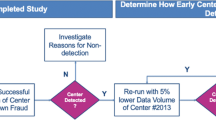Abstract
We describe a methodology for identifying and ranking candidate audit targets from a database of prescription drug claims. The relevant audit targets may include various entities such as prescribers, patients and pharmacies, who exhibit certain statistical behavior indicative of potential fraud and abuse over the prescription claims during a specified period of interest. Our overall approach is consistent with related work in statistical methods for detection of fraud and abuse, but has a relative emphasis on three specific aspects: first, based on the assessment of domain experts, certain focus areas are selected and data elements pertinent to the audit analysis in each focus area are identified; second, specialized statistical models are developed to characterize the normalized baseline behavior in each focus area; and third, statistical hypothesis testing is used to identify entities that diverge significantly from their expected behavior according to the relevant baseline model. The application of this overall methodology to a prescription claims database from a large health plan is considered in detail.





Similar content being viewed by others
References
Aral KD, Güvenir HA, Sabuncuoğlu İ, Akar AR (2012) A prescription fraud detection model. Comput Methods Prog Biomed 106:37–46
Becker RA, Volinsky C, Wilks AR (2010) Fraud dtection in telecommunications: history and lessons learned. Technometrics 52(1):22–33
Bolton RJ, Hand DJ (2001) Unsupervised profiling methods for fraud detection, Credit scoring and credit control VII. Edinburgh
Bolton RJ, Hand DJ (2002) Statistical fraud detection: a review (with discussion). Stat Sci 17(3):235–255
Clinical classifications software for ICD-9-CM, http://www.hcup-us.ahrq.gov/toolssoftware/ccs/ccs.jsp#download
Cohen W (1995) Fast effective rule induction In: Proceedings of the twelfth international conference on machine learning, pp 115–123
Hand DJ (2010) Fraud detection in telecommunications and banking: discussion of Becker, Volinsky and Wilks (2010) and Sudjianto et al. (2010), 52(1):34–38
Hoffmann DE, Tarzian AJ (2003) Achieving the right balance in oversight of physician opiod prescribing for pain: the role of state medical boards. J Law Med Ethics 31:21–40
Hosmer DW, Hosmer T, Le Cessie S, Lemeshow S (1997) A comparison of goodness-of-fit tests for the logistic regression model. Stat Med 16:965–980
Hyman DA (2001) Health care fraud and abuse: market change, social norms, and the trust "reposed in the workmen". J Leg Stud XXX:531–567
Inciardi JA, Surratt HL, Kurtz SP, Cicero TJ (2007) Mechanisms of prescription drug diversion among drug-involved club-and street-based populations. Pain Med 8(2):171–183
Iyengar V, Boier I, Kelley K, Curatolo R (2007) Analytics for audit and business controls in corporate travel and entertainment. In: Proceedings sixth australasian data mining conference (AusDM 2007) CRPIT, vol 70. Gold Coast, pp 3–12
Kulldorff M (1997) A spatial scan statistic. Commun Statist Theor Meth 26(6):1481–1496
Kulldorff M, Mostashari F, Duczmal L, Yih K, Kleinman K, Platt R (2007) Multivariate spatial scan statistics for disease surveillance. Stat Med 26:1824–1833
Leap TL (2011) Phantom billing, fake prescriptions, and the high cost of medicine. Cornell University Press, Ithaca
Li J, Huang KY, Jin J, Shi J (2008) A survey on statistical methods for health care fraud detection. Health Care Manag Sci 11(3):275–287
National Institute On Drug Abuse (2011), Prescription Drugs: addiction and abuse, Research Report Series, National Institutes of Health (NIH) Publication Number 11-4881, revised
Phua C, Lee VCS, Smith K, Gayler R (2005) A comprehensive survey of data mining-based fraud detection research. CoRR: 1–14. arxiv:1009.6119
Quinlan JR, Cameron Jones RM (1993) FOIL: A midterm report machine learning: ECML 93, LNCS. Springer Verlag, p 667
Rousseeuw PJ, Leroy AM (2005) Robust regression and outlier detection. In: Wiley series in probability and statistics
Sudjianto A, Nair S, Yuan M, Zhang A, Kern D, Cela-Diaz F (2010) Stat Methods Fighting Financ Crimes 52(1):5–19
Travaille P, Muller RM, Thornton D, van Hillegersberg J (2011) Electronic fraud detection in the U.S. medicaid healthcare program: lessons learned from other industries. In: Proceedings of the seventeenth americas conference on information systems. Detroit
United States General Accounting Office (2000) Health care fraud. schemes to defraud, medicare, medicaid and private health insurers. GAO/T-OSI-00-15
Acknowledgments
We thank the health plan staff responsible for audits and fraud prevention and detection for their support and guidance during this project. We also thank the reviewers for their feedback and suggestions.
Author information
Authors and Affiliations
Corresponding author
Rights and permissions
About this article
Cite this article
Iyengar, V.S., Hermiz, K.B. & Natarajan, R. Computer-aided auditing of prescription drug claims. Health Care Manag Sci 17, 203–214 (2014). https://doi.org/10.1007/s10729-013-9247-x
Received:
Accepted:
Published:
Issue Date:
DOI: https://doi.org/10.1007/s10729-013-9247-x




